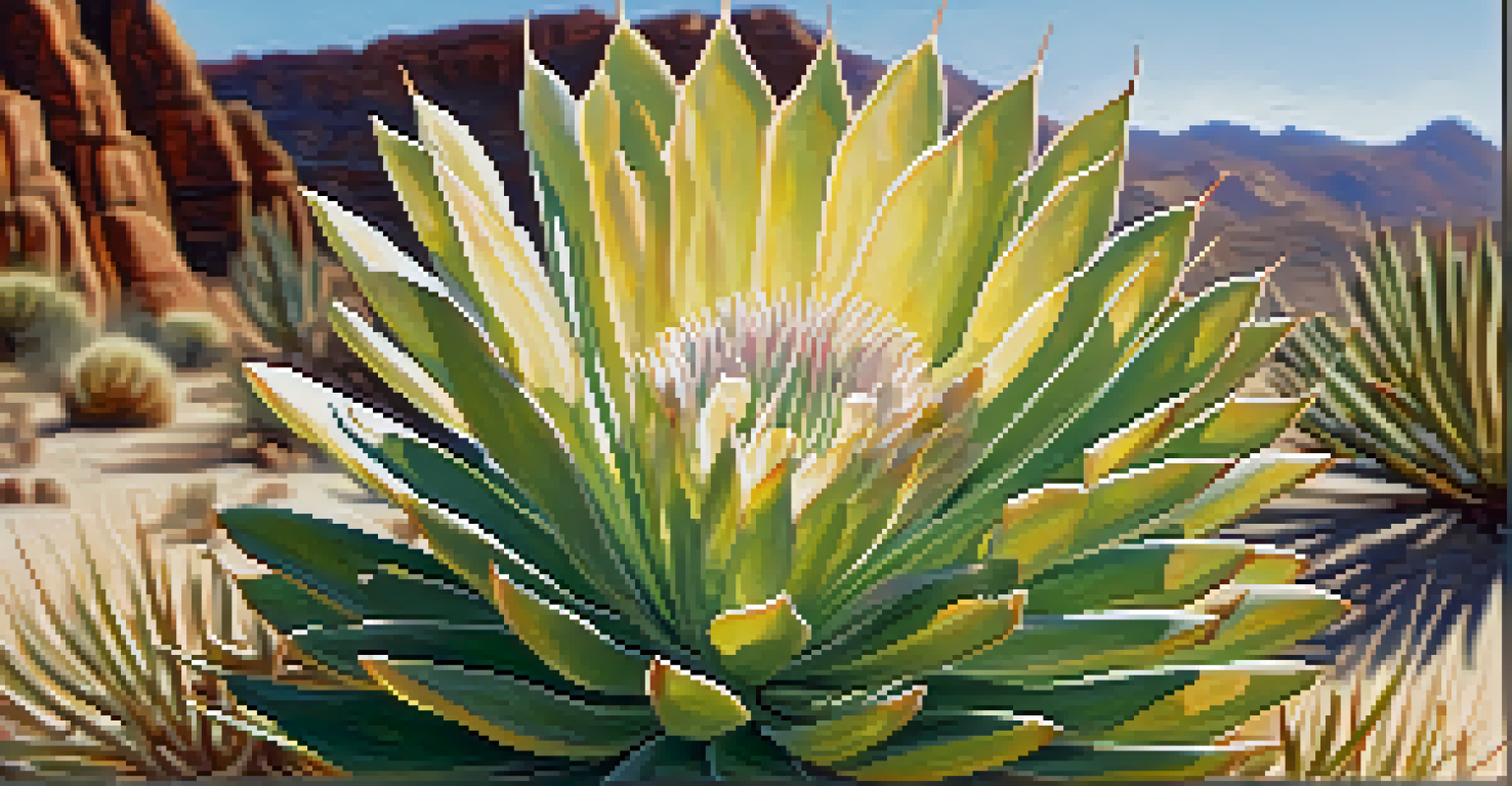Arizona's Deserts: A Source of Inspiration in Western Literature

The Allure of Arizona's Desert Landscapes
Arizona's deserts boast stunning landscapes that captivate the imagination. With their vibrant sunsets and unique rock formations, these terrains offer a backdrop that has inspired countless writers. The stark beauty of the desert often contrasts with the complexities of human emotion, creating a rich tapestry for storytelling.
The desert tells a different story every time one ventures into it.
For many authors, the desert symbolizes both isolation and freedom, allowing characters to confront their inner struggles. This duality invites readers to explore themes of survival, resilience, and self-discovery. Think of how the vast, open spaces mirror the characters' journeys through life.
In Western literature, these landscapes become more than mere settings; they transform into characters themselves. Writers like Edward Abbey and Barry Lopez have used the Arizona desert to reflect on environmental issues, urging readers to appreciate and protect these natural wonders.
Symbolism of the Desert in Western Narrative
Deserts often symbolize harsh realities and the journey toward self-realization. In many Western novels, the arid landscape serves as a backdrop for characters grappling with their identity. The unforgiving nature of the desert mirrors the struggles faced by protagonists, making their journeys all the more poignant.

Authors like Zane Grey have portrayed the desert as a character that challenges and shapes the narrative. The dry, expansive terrain forces characters to confront their fears and desires, offering a rich ground for personal growth. This interplay between character and setting enhances the depth of the story.
Desert Landscapes Inspire Storytelling
Arizona's stunning deserts serve as a backdrop for rich narratives, symbolizing isolation and freedom while inviting themes of survival and self-discovery.
Moreover, the desert's vastness invites themes of solitude and introspection. Writers often depict solitary figures navigating the wilderness, emphasizing the idea of finding one's place in the world. This exploration of solitude resonates deeply with readers, making the desert an enduring source of inspiration.
Cultural Influences on Desert Literature
Arizona's deserts are not just physical landscapes; they are cultural crossroads that influence literary themes. The rich history of Indigenous peoples in the region adds layers to the narratives inspired by the desert. Many contemporary authors draw from these cultural stories, weaving them into their works.
In every walk with nature, one receives far more than he seeks.
Writers like Leslie Marmon Silko incorporate Indigenous perspectives to highlight the sacredness of the land. This blending of cultures enriches Western literature, providing a nuanced view of the desert and its significance. Readers gain insight into the connection between land, identity, and heritage.
The cultural tapestry of Arizona reflects a diverse mix of influences, from Spanish explorers to modern settlers. This melting pot of stories and histories invites authors to explore themes of conflict and coexistence, adding depth to their narratives. Ultimately, the desert becomes a symbol of resilience and adaptation.
Notable Works Featuring Arizona's Desert
Several literary works stand out for their vivid portrayals of Arizona's deserts. One such example is 'Desert Solitaire' by Edward Abbey, where the author reflects on the beauty and fragility of nature. His passionate prose not only paints a picture of the landscapes but also advocates for environmental preservation.
Another notable work is 'The Bean Trees' by Barbara Kingsolver, which uses the desert setting to explore themes of family and belonging. The challenges faced by the characters in the harsh environment highlight the importance of community and support. This connection between setting and character development is a hallmark of great storytelling.
Cultural Influences Shape Narratives
The diverse cultural history of Arizona's deserts enriches literary themes, blending Indigenous perspectives with contemporary stories to highlight the connection between land and identity.
Additionally, ‘The Little House’ series by Laura Ingalls Wilder touches on the experiences of pioneers in desert landscapes. These works emphasize the struggles and triumphs of individuals against the backdrop of the unforgiving desert, reflecting broader themes of survival and resilience.
The Desert as a Space for Reflection
In literature, the desert serves as a powerful space for reflection and contemplation. Characters often find themselves in moments of solitude, prompting introspection and personal growth. This transformative experience resonates with readers, encouraging them to reflect on their own lives.
The quiet of the desert landscape creates an atmosphere conducive to self-discovery. Authors use this setting to explore the internal struggles of their characters, illustrating how isolation can lead to clarity. The vastness of the desert mirrors the limitless possibilities of understanding oneself.
Moreover, the desert's stark beauty often evokes a sense of peace, allowing both characters and readers to pause and think. This powerful connection between environment and emotion enhances the storytelling experience, making the desert a compelling literary device.
Environmental Themes in Desert Literature
Arizona's deserts are not just beautiful; they also raise important environmental themes in literature. Authors often grapple with issues such as conservation and sustainability, urging readers to recognize the fragility of these ecosystems. This awareness fosters a deeper connection between readers and the natural world.
Writers like Aldo Leopold have highlighted the importance of respecting and protecting the desert environment. Their works serve as a call to action, encouraging readers to consider their relationship with nature. This theme of stewardship resonates strongly in contemporary literature, making it relevant to today's audience.
Environmental Themes in Literature
Literary works set in Arizona's deserts often address crucial environmental issues, urging readers to reflect on conservation and their relationship with nature.
Furthermore, the desert landscape often acts as a metaphor for human impact on the environment. As characters navigate their challenges, they also confront the consequences of their actions on the land. This dual narrative enriches the story, prompting readers to reflect on their roles in preserving the beauty of Arizona's deserts.
The Enduring Legacy of Desert Literature
The legacy of desert literature continues to inspire new generations of writers and readers alike. As authors explore the complexities of the desert, they contribute to a rich literary tradition that resonates with contemporary themes. This ongoing dialogue ensures that the stories of Arizona's deserts remain vital and relevant.
Moreover, the unique challenges posed by the desert landscape inspire innovative storytelling techniques. Writers are pushing the boundaries of narrative structure and style, reflecting the dynamic nature of the environment. This creativity not only captivates readers but also encourages them to see the desert in new ways.

Ultimately, the desert remains a powerful source of inspiration, inviting exploration and reflection. As we delve into these literary works, we uncover deeper truths about ourselves and our relationship with the world around us. The stories born from Arizona's deserts will continue to resonate, reminding us of the beauty and complexity of life.